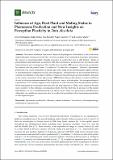Por favor, use este identificador para citar o enlazar a este item:
http://hdl.handle.net/10261/188954COMPARTIR / EXPORTAR:
 SHARE SHARE
 CORE
BASE CORE
BASE
|
|
| Visualizar otros formatos: MARC | Dublin Core | RDF | ORE | MODS | METS | DIDL | DATACITE | |

| Título: | Influence of age, host plant and mating status in pheromone production and new insights on perception plasticity in Tuta Absoluta |
Autor: | Domínguez, Aroa CSIC; López Martín, Sergio ; Bernabé, Ana; Guerrero, Ángel CSIC ORCID; Quero, Carmen CSIC ORCID | Fecha de publicación: | 20-ago-2019 | Editor: | Multidisciplinary Digital Publishing Institute | Citación: | Insects 10(8): 256 (2019) | Resumen: | The tomato leafminer <i>Tuta absoluta</i> Meyrick (Lepidoptera: Gelechiidae) is one of the most important pests of tomato worldwide. However, in spite of its tremendous economic importance, the success of environmentally friendly measures to control the pest is still limited. Study of physiological and behavioral parameters that affect pheromone production has provided useful information for pest management. Our results show no clear difference in pheromone production by females over the period from 2 h before to 2 h after the scotophase. However, pheromone production was clearly dependent on female age, with young females producing the highest amount of each pheromone component 10 days after emergence. In the presence of the host plant (physical contact and olfaction of the plant volatiles), virgin and mated females produced higher amounts of the major component of the pheromone (TDTA) than those in the absence of plant and those devoid of olfaction (antennectomized) but in physical contact with the plant. In electrophysiological experiments, TDTA elicited slightly lower responses on male antennae than the pheromone mixture. When stimulated at certain time intervals after the first exposure to TDTA, male antennae became more sensitive to the stimulus (sensitization effect). For the first time in an insect of the family Gelechiidae, we have found that females are able to detect their own pheromone (autodetection). Altogether, our results may represent a step forward in the knowledge of the chemical communication of this important pest. | Descripción: | © 2019 by the authors. | Versión del editor: | https://doi.org/10.3390/insects10080256 | URI: | http://hdl.handle.net/10261/188954 | DOI: | 10.3390/insects10080256 | ISSN: | 2075-4450 | E-ISSN: | 2075-4450 |
| Aparece en las colecciones: | (IQAC) Artículos |
Ficheros en este ítem:
| Fichero | Descripción | Tamaño | Formato | |
|---|---|---|---|---|
| Influence_Dominguez_Art2019.pdf | 1,2 MB | Adobe PDF |  Visualizar/Abrir |
CORE Recommender
PubMed Central
Citations
2
checked on 15-abr-2024
SCOPUSTM
Citations
10
checked on 24-abr-2024
WEB OF SCIENCETM
Citations
7
checked on 28-feb-2024
Page view(s)
246
checked on 24-abr-2024
Download(s)
196
checked on 24-abr-2024

